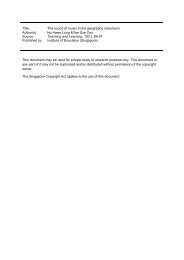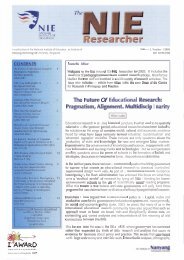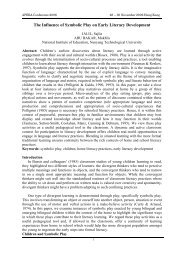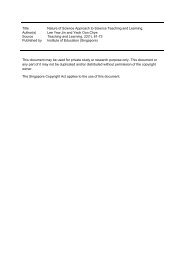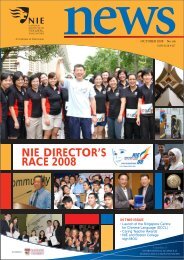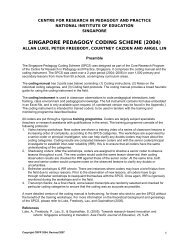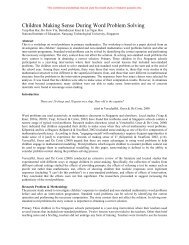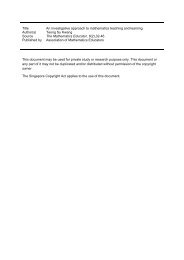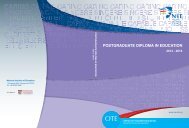Cooperative Learning - NIE Digital Repository - National Institute of ...
Cooperative Learning - NIE Digital Repository - National Institute of ...
Cooperative Learning - NIE Digital Repository - National Institute of ...
Create successful ePaper yourself
Turn your PDF publications into a flip-book with our unique Google optimized e-Paper software.
126 John Tan and Michael KohTypically, verbal feedback is the predominant means <strong>of</strong> intervention in theteaching <strong>of</strong> motor skills (Magill, 1993). This would require teachers to encodea physical performance into words and the students to decode the verbalfeedback into physical performance. But this mode <strong>of</strong> communication canresult in disappointing outcomes, such as a misunderstanding <strong>of</strong> the feedbackgiven.Motor learning researchers (McCullagh and Caird, 1990; Wood,Gallagher, Martino and Ross, 1992) have shown that demonstrations, picturesor other visual models that provide information about a movementare more effective than the use <strong>of</strong> only verbal input in teaching a new pattern<strong>of</strong> coordination. With the coming <strong>of</strong> the IT age, teachers are able tocommunicate vividly, conveniently, as well as accurately the quality <strong>of</strong> aphysical performance via video and computer technology. In fact, video issuch an excellent visualization tool that teachers can use it to facilitate thelearning process by showing video clips as <strong>of</strong>ten as necessary thus enablinglearners to encode and memorize relevant movements more easily. It is <strong>of</strong>no surprise that Knudson and Morrison (2002) asserted that video is aneffective way <strong>of</strong> increasing observational ability. Fenrich (1997) also notedthat video can illustrate realistic representations <strong>of</strong> procedures andprocesses in order to gain and focus learners' attention. Basically, learnersare more motivated to view their own performances for a variety <strong>of</strong> reasons.But from the skill learning perspective, viewing one's own performance isthe most realistic form <strong>of</strong> feedback. In physical activities, performers wouldnever have a chance to view their own performances unless they wererecorded. Video not only provides good recordings <strong>of</strong> performances, it isalso allows learners to focus on key movements as recorded motions can bereplayed at a slower pace or be "paused" for clearer viewing.In designing the e-learning module, cognitive information processing(Driscoll, 2000) and constructivist (Jonassen, 1994) pedagogical perspectiveswere used. Using information processing theory, emphasis wasplaced on focusing learners' attention on important information and providinglearning activities that engaged them in rehearsal or elaboration <strong>of</strong>information. Reinforcement through practice and feedback were providedby means <strong>of</strong> a pop-up quiz. Through constructivism, learners activelyengaged and constructed meaning not only from content provided on theWeb but also from collaborative dialogue with others.



